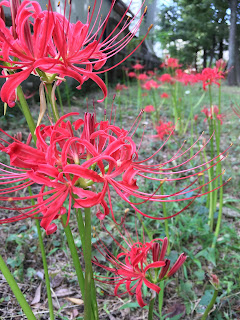 |
| Red Spider Lilies (Higanbana) in bloom |
 The weather remains quite warm here in Japan but a sure sign that autumn is finally here - apart from more typhoons - is the appearance of the red spider lily known as higan-bana (彼岸花), also called manjushage (曼珠沙華). In nearby Tachikawa Showa Kinen Park, more than 20,000 are in bloom and the best time for seeing (migoro =見頃) what is described as a "bright-red carpet" (真っ赤なじゅうだん) is apparently this weekend. A bit further away, Kinchakuda (Hidaka City) boasts 5 million (!) (500万) of the plants spread over 5.2 hectares through early October (see poster right).
The weather remains quite warm here in Japan but a sure sign that autumn is finally here - apart from more typhoons - is the appearance of the red spider lily known as higan-bana (彼岸花), also called manjushage (曼珠沙華). In nearby Tachikawa Showa Kinen Park, more than 20,000 are in bloom and the best time for seeing (migoro =見頃) what is described as a "bright-red carpet" (真っ赤なじゅうだん) is apparently this weekend. A bit further away, Kinchakuda (Hidaka City) boasts 5 million (!) (500万) of the plants spread over 5.2 hectares through early October (see poster right). The name of the flower itself - higan - comes from the fact that they bloom around autumn equinoctial week which is called aki no o higan (秋のお彼岸) in Japanese. The middle day of equinoctial week comes on the day of the autumn equinox known as shūbun no hi = 秋分の日 (a national holiday that falls on September 23rd this year) so the week itself comprises the three days before and after that day. Higan alone refers to the Buddhist holiday celebrated in Japan during both the spring and autumn quinox and means "the other side of the river" the state of enlightment without worldly desires - in other words, Nirvana. During this period, much like Obon, Japanese sometimes visit their ancestor's graves and hold a memorial service for them
or simply offer sticky-rice-filled sweets covered in thick red-bean paste (tsubuan) - or sometimes sweet soy flour (kinako) - at the household Buddhist altar (butsudan =仏壇). These sweets are known as o-hagi (御萩) in autumn and botamochi (牡丹餅) in the spring, though they are actually a common sight in supermarkets all-year round (pictured).
The name of the flower itself - higan - comes from the fact that they bloom around autumn equinoctial week which is called aki no o higan (秋のお彼岸) in Japanese. The middle day of equinoctial week comes on the day of the autumn equinox known as shūbun no hi = 秋分の日 (a national holiday that falls on September 23rd this year) so the week itself comprises the three days before and after that day. Higan alone refers to the Buddhist holiday celebrated in Japan during both the spring and autumn quinox and means "the other side of the river" the state of enlightment without worldly desires - in other words, Nirvana. During this period, much like Obon, Japanese sometimes visit their ancestor's graves and hold a memorial service for them
or simply offer sticky-rice-filled sweets covered in thick red-bean paste (tsubuan) - or sometimes sweet soy flour (kinako) - at the household Buddhist altar (butsudan =仏壇). These sweets are known as o-hagi (御萩) in autumn and botamochi (牡丹餅) in the spring, though they are actually a common sight in supermarkets all-year round (pictured).Buddhism is of course closely related to death in Japan - funerals are Buddhist and graveyards are found in temples - so it is no surprise that the lily is also known as the flower of death. This image is strengthened by its presence in graveyards and at funerals. Being poisonous to small animals they used to be planted around graveyards in Japan's pre-cremation days to stop the dead bodies being eaten (today, of course, cremation is obligatory in Japan). And their appearance at funerals is said to due to their bright colour thought to help guide departing souls to the afterlife. But whatever deathly connotations they may have, they are a beautiful sight and a welcome symbol of cooler days to come.

No comments:
Post a Comment
Have a comment? Let us know what you think! All comments are moderated so there will be a slight delay until it’s published.